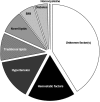Impact of inactivity and exercise on the vasculature in humans
- PMID: 19943061
- PMCID: PMC2829129
- DOI: 10.1007/s00421-009-1260-x
Impact of inactivity and exercise on the vasculature in humans
Abstract
The effects of inactivity and exercise training on established and novel cardiovascular risk factors are relatively modest and do not account for the impact of inactivity and exercise on vascular risk. We examine evidence that inactivity and exercise have direct effects on both vasculature function and structure in humans. Physical deconditioning is associated with enhanced vasoconstrictor tone and has profound and rapid effects on arterial remodelling in both large and smaller arteries. Evidence for an effect of deconditioning on vasodilator function is less consistent. Studies of the impact of exercise training suggest that both functional and structural remodelling adaptations occur and that the magnitude and time-course of these changes depends upon training duration and intensity and the vessel beds involved. Inactivity and exercise have direct "vascular deconditioning and conditioning" effects which likely modify cardiovascular risk.
Figures


References
-
- Adams V, Linke A, Krankel N, Erbs S, Gielen S, Mobius-Winkler S, Gummert JF, Mohr FW, Schuler G, Hambrecht R. Impact of regular physical activity on the NAD(P)H oxidase and angiotensin receptor system in patients with coronary artery disease. Circulation. 2005;111:555–562. - PubMed
-
- Allen AD, Geaghan JP, Greenway F, Welsch MA. Time course of improved flow-mediated dilation after short-term exercise training. MSSE. 2003;35:847–853. - PubMed
-
- Andreozzi GM, Leone A, Laudani R, Deinite G, Martini R. Acute impairment of the endothelial function by maximal treadmill exercise in patients with intermittent claudication, and its improvement after supervised physical training. Int Angiol. 2007;26:12–17. - PubMed
-
- Bank AJ, Shammas RA, Mullen K, Chuang PP. Effects of short-term forearm exercise training on resistance vessel endothelial function in normal subjects and patients with heart failure. J Card Fail. 1998;4:193–201. - PubMed
Publication types
MeSH terms
LinkOut - more resources
Full Text Sources
Medical

